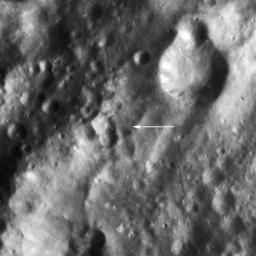
|
Claudia: A Tiny Crater Chosen to Define Vesta’s Prime Meridian
- Click the image above for a larger view
- Full-Res JPEG (1024 x 1024) (81.5 kB)
- Full-Res TIFF (1024 x 1024) (1.1 MB)
Caption:
When NASA's Dawn spacecraft arrived at Vesta, one of the first tasks was to determine the precise orientation of the asteroid's rotation axis and its equator. To do that, scientists defined a prime meridian from which 360 degrees can be counted to the east or west. The image shows Claudia (arrow), a tiny crater of about 1500 yards (500 meters) in diameter -- named by the Dawn science team -- through which by definition Vesta's prime meridian runs from the asteroid's north pole to its south pole. This image was obtained at an altitude of 1,700 miles (2,700 kilometers) altitude above the surface of Vesta. Image resolution is about 260 meters per pixel.
Background Info:
The Dawn mission to Vesta and Ceres is managed by NASA's Jet Propulsion Laboratory, a division of the California Institute of Technology in Pasadena, for NASA's Science Mission Directorate, Washington. UCLA is responsible for overall Dawn mission science. The Dawn framing cameras were developed and built under the leadership of the Max Planck Institute for Solar System Research, Katlenburg-Lindau, Germany, with significant contributions by DLR German Aerospace Center, Institute of Planetary Research, Berlin, and in coordination with the Institute of Computer and Communication Network Engineering, Braunschweig. The Framing Camera project is funded by the Max Planck Society, DLR, and NASA/JPL.More information about Dawn is online at http://www.nasa.gov/dawn and http://dawn.jpl.nasa.gov .
Cataloging Keywords:
| Name | Value | Additional Values |
|---|---|---|
| Target | 4 Vesta | |
| System | Main Belt | |
| Target Type | Asteroid | |
| Mission | Dawn | |
| Instrument Host | Dawn | |
| Host Type | Orbiter | |
| Instrument | Framing Camera (FC) | |
| Detector | ||
| Extra Keywords | Crater, Grayscale, Rotation | |
| Acquisition Date | ||
| Release Date | 2011-09-16 | |
| Date in Caption | ||
| Image Credit | NASA/JPL-Caltech/UCLA/MPS/DLR/IDA | |
| Source | photojournal.jpl.nasa.gov/catalog/PIA14715 | |
| Identifier | PIA14715 | |
